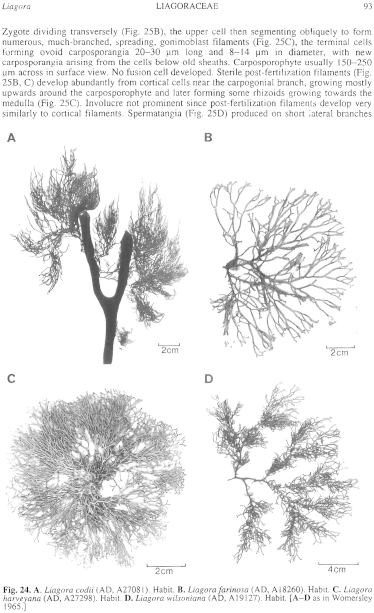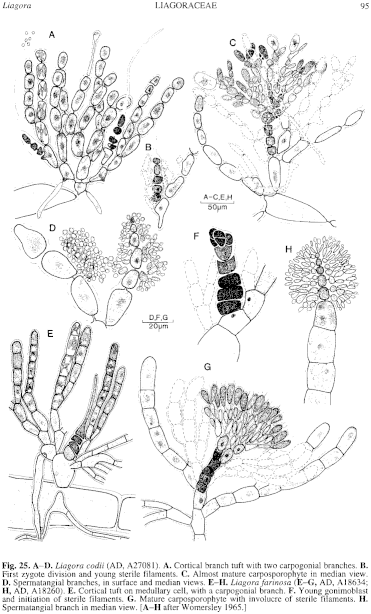|
|
|
|
|
|||||||||||
|
Electronic Flora of South Australia Species Fact Sheet
Phylum Rhodophyta – Class Florideophyceae – Order Nemaliales – Family Liagoraceae
Thallus (gametophyte) (Fig. 24A) red-brown, only slightly calcified, 5–20 (–30) cm high, usually growing on Codium, subdichotomously to irregularly and laterally branched in the lower parts at intervals of usually less than 1 cm, less so above, sometimes with unbranched ends 1–3 cm long, 0.6–1 (–2) mm in diameter below, usually tapering only slightly above. Holdfast of bundles of rhizoids between host utricles. Structure of a medulla of large, elongate cells 50–100 µm in diameter, mixed with abundant slender rhizoids, and a cortex (Fig. 25A) 200–300 vim broad, of dense tufts of cortical filaments which originate from the anterior end of medullary cells; cortical filaments (Fig. 25A) branched near their bases, straight or slightly curved, usually slightly moniliform and constricted at the cross walls, cells ovoid, 10–15 µm in diameter and L/D 1–2 (–3); rhodoplasts stellate to lobed, with a central pyrenoid. Basal cells of branch tufts producing slender rhizoids which grow over and between the medullary cells (Fig. 25A).
Reproduction: Sexual thalli dioecious. Carpogonial branches (Fig. 25A) borne on the lower cells of the branch tufts, almost straight, 3 or 4 cells long with a conical carpogonium.
Type from Port Lincoln, S. Aust., on Codium duthieae, 6–8 m deep near Snapper Rock (R. Baldock, 1.i.1964); in AD, A27081.
Selected specimens: Margaret Brock Reef, Cape Jaffa, S. Aust., on Codium duthieae, 3 m deep (AIMS-NCI, Q66C 2479-L, 18.ii.1989; AD, A59609). Nora Creina, S. Aust., on C. duthieae, drift (Abbott & Womersley, 7.xi.1965; AD, A29633). Warrnambool, Vic., on Codium (Watts, Dec. 1859; TCD). Port Phillip Heads, Vic. (Wilson, 2.i.1890; MEL, 8571; 14.i.1889; MEL, 8572 and 22.xii.1891; MEL, 8570).
Taxonomic notes: Zygote dividing transversely (Fig. 25B), the upper cell then segmenting obliquely to form numerous, much-branched, spreading, gonimoblast filaments (Fig. 25C), the terminal cells forming ovoid carposporangia 20–30 µm long and 8–14 µm in diameter, with new carposporangia arising from the cells below old sheaths. Carposporophyte usually 150–250 µm across in surface view. No fusion cell developed. Sterile post-fertilization filaments (Fig. 25B, C) develop abundantly from cortical cells near the carpogonial branch, growing mostly upwards around the carposporophyte and later forming some rhizoids growing towards the medulla (Fig. 25C). Involucre not prominent since post-fertilization filaments develop very similarly to cortical filaments. Spermatangia (Fig. 25D) produced on short lateral branches just below apex of cortical filaments, occasionally on the end of the cortical filament itself, forming dense elongate-ovoid heads 20–30 µm in diameter and 30–60 µm long, consisting of a central row of 4–8 cells cutting off 2–3 orders of cells and ultimately ovoid to spherical spermatangia 2–3 µm in diameter.
Distribution: Port Lincoln, S. Aust., to Port Phillip Heads, Vic., on Codium duthieae.
L. codii belongs to the L. farinosa group, but differs in being a more slender plant with more frequent branching and often with irregular laterals. It is only very slightly calcified and the cortical filaments consist of ovoid cells separated by distinct constrictions. The carposporophyte is more loosely branched with carposporangia more ovoid than in L. farinosa, and the spermatangial heads are mostly lateral below the apices of the cortical filaments. The only known host is Codium duthieae.
References:
WOMERSLEY, H.B.S. (1965). The Helminthocladiaceae (Rhodophyta) of southern Australia. Aust. J. Bot. 13, 451–487, Plates 1–7.
The Marine Benthic Flora of Southern Australia Part IIIA complete list of references.
Publication:
Womersley, H.B.S. (14 January, 1994)
The Marine Benthic Flora of Southern Australia
Rhodophyta. Part IIIA, Bangiophyceae and Florideophyceae (to Gigartinales)
Reproduced with permission from The Marine Benthic Flora of Southern Australia Part IIIA 1994, by H.B.S. Womersley. Australian Biological Resources Study, Canberra. Copyright Commonwealth of Australia.
Illustrations in Womersley Part IIIA, 1994: FIGS 24A, 25 A–D.

Figure 24 enlarge
Fig. 24. A. Liagora codii (AD, A27081). Habit. B. Liagora farinosa (AD, A18260). Habit. C. Liagora harveyana (AD, A27298). Habit. D. Liagora wilsoniana (AD, A19127). Habit. [A–D as in Womersley 1965.]

Figure 25 enlarge
Fig. 25. A–D. Liagora codii (AD, A27081). A. Cortical branch tuft with two carpogonial branches. B. First zygote division and young sterile filaments. C. Almost mature carposporophyte in median view. D. Spermatangial branches, in surface and median views. E–H. Liagora farinosa (E–G, AD, A18634; H, AD, A18260). E. Cortical tuft on medullary cell, with a carpogonial branch. F. Young gonimoblast and initiation of sterile filaments. G. Mature carposporophyte with involucre of sterile filaments. H. Spermatangial branch in median view. [A–H after Womersley 1965.]

|
Email Contact: State Herbarium of South Australia |

|